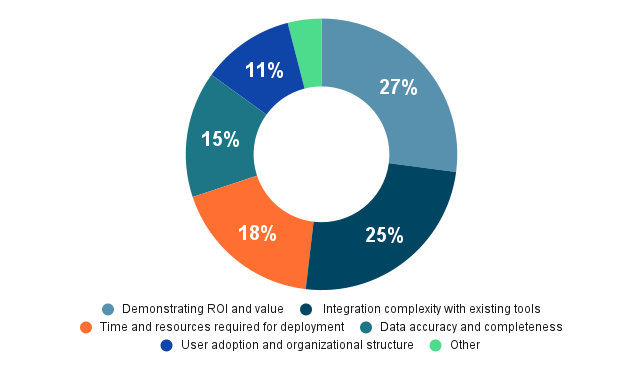The Keys to Implementing Exposure Management

Each Monday, the Tenable Exposure Management Academy provides the practical, real-world guidance you need to shift from vulnerability management to exposure management. In this post, we look at the results of a survey taken during a recent Tenable webinar on hesitations around exposure management. You can read the entire Exposure Management Academy series here.
The concept of a unified exposure management platform that consolidates all risk data into a single view makes a lot of sense. The promise is real: reduce noise, improve prioritization and align security efforts with business objectives.
In a recent webinar, Security Without Silos: Gain Real Risk Insights with Exposure Management Upsized, attendees showed significant interest in this approach. More than a quarter of the audience said they are either actively implementing or exploring an exposure management program.
Adopting any new enterprise-wide platform can seem daunting, and Tenable’s live polling confirmed the key sources of hesitation.
When asked about their biggest concerns regarding the implementation of an exposure management platform, attendees were clear: 27% were concerned about demonstrating ROI and value, 25% wondered about integration complexity with existing tools and 18% worried about time and resources required for deployment.
Exposure management hesitations

Source: Tenable webinar poll of 89 respondents, April 2025
These issues are valid concerns that deserve direct answers. Let's tackle the top three one by one, using insights from the webinar to show how a modern approach to exposure management can help overcome these challenges.
1. Proving ROI to leadership
Securing budget dollars for any technology requires a clear view into the value it will provide to the organization. But ROI for security tools can sometimes feel hard to pin down. So, how do you translate technical findings into business value?
Above all, unified exposure management drives efficiency, consolidating work and tools under an umbrella program. With a single data store, the tools work more efficiently, security teams can focus on high-value areas and constituents around the enterprise get the information they need in unified dashboards.
That sounds good. But you need to scale. Mention that word to any tech or finance leader and all they’ll see are dollar signs. It usually means more licenses, more tech resources and more headcount. And it definitely doesn’t help you build your ROI argument. In fact, it’s often a great recipe for blowing your budgets out of the water.
This is where an exposure management platform can help.
Rather than continuing the typical linear, siloed approach, an exposure management platform requires only a portion of your available staff and budget to scale security horizontally. It extends visibility across all assets and risks in your attack surface by collecting data across your disparate tools. Then it adds critical context that can identify and prioritize the exposures that matter.
When it comes to showing ROI, the ability to consolidate and scale efficiently are hard to beat.
2. Integration with existing tools will be too complex
The fear of a complex integration often stems from past experiences with legacy systems that required deploying more agents, cumbersome network changes and brittle custom scripts.
Many worry that a new platform will only add to their technical debt.
The reality is that modern exposure management platforms are fundamentally different. As the webinar showed, these systems are built on an API-first philosophy.
Rather than ripping and replacing your existing security stack, a platform like Tenable One is designed to ingest data from it. Through pre-built connectors and flexible APIs, it pulls findings from your existing endpoint detection products, cloud security tools and other security solutions.
This approach consolidates your security data without adding intrusive agents, making the integration process far less complex than anticipated.
3. We don't have the time or resources for a massive deployment
Time and resources may be the most common barrier to change. With teams already stretched thin — a fact confirmed by 55% of attendees who cited resource constraints — the idea of a months-long, "big bang" deployment is a non-starter.
Pragmatism is the key.
As the webinar showed, you don’t have to "boil the ocean.” A successful exposure management implementation is not an all-or-nothing affair.
The best approach is to start small and scope the program for a feasible, high-impact win. Focus on a single team, a specific business unit or one critical use case. Maybe building a unified asset inventory for your cloud infrastructure would be a good start.
By showing success in one area, you can build momentum, secure broader buy-in and expand the program organically over time. This phased approach respects your team's limited resources while delivering incremental value.
Although the concerns around implementing a new program are understandable, a modern, pragmatic approach to exposure management can address them and offer a path to reduced risk and demonstrable value. In the analyst report titled How to grow vulnerability management into exposure management, you can learn the best ways to get started.
Takeaways
ROI is achievable with a unified exposure management platform. It drives efficiency through proactive cyber hygiene, enables risk-based prioritization to identify "choke points" and offers unified dashboards for business-centric reporting.
As an API-first platform with pre-built connectors, exposure management simplifies integration. Best of all, you can deploy in phases. Start small with a single team or critical use case and then translate that success into a broader program.
Learn more
- Check out the Tenable exposure management resource center to discover the value of exposure management and explore resources to help you stand up a continuous threat exposure management program.
- Exposure Management
- Exposure Management Academy


